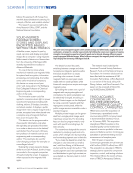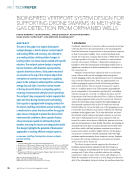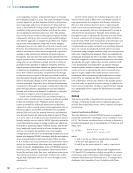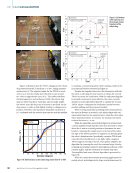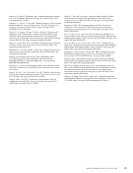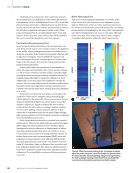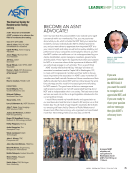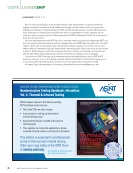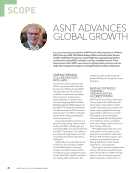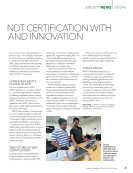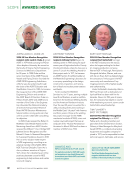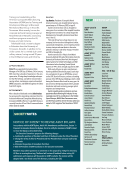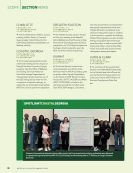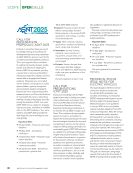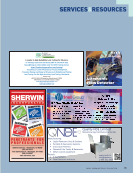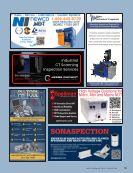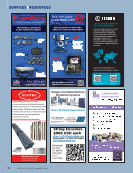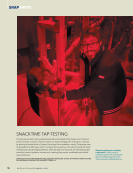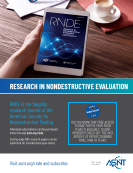RESEARCHERS
DEVELOP
NEW METHOD
TO AMPLIFY
BIOELECTRONIC
SENSING
In a breakthrough that could transform bioelectronic
sensing, an interdisciplinary team of researchers at
Rice University (Houston, TX) has developed a new
method to dramatically enhance the sensitivity of
enzymatic and microbial fuel cells using organic
electrochemical transistors (OECTs). The research
was recently published in the journal Device.
The innovative approach amplifies electrical
signals by three orders of magnitude and improves
signal-to-noise ratios, potentially enabling the next
generation of highly sensitive, low-power biosensors
for health and environmental monitoring.
“We have demonstrated a simple yet powerful
technique to amplify weak bioelectronic signals
using OECTs, overcoming previous challenges in
integrating fuel cells with electrochemical sensors,”
said corresponding author Rafael Verduzco,
professor of chemical and biomolecular engineering
and materials science and nanoengineering. “This
method opens the door to more versatile and effi-
cient biosensors that could be applied in medicine,
environmental monitoring, and even wearable
technology.”
Traditional biosensors rely on direct interactions
between target biomolecules and the sensor device,
which can pose limitations when the electrolyte envi-
ronment is incompatible. This research circumvents
that challenge by electronically coupling fuel cells
with OECTs instead of introducing biomolecules
directly into the sensor.
“One of the biggest hurdles in bioelectronic
sensing has been designing systems that work in
different chemical environments without compro-
mising performance,” said corresponding author
Caroline Ajo-Franklin, professor of biosciences,
director of the Rice Synthetic Biology Institute, and
Cancer Prevention and Research Institute of Texas
(CPRIT) Scholar. “By keeping the OECT and fuel cell
separate, we ensured optimal conditions for both
components while still achieving powerful signal
amplification.”
OECTs are thin-film transistors that operate in
aqueous environments and have gained attention
for their high sensitivity and low-voltage operation.
For the study, the team integrated OECTs with two
types of biofuel cells to enhance their performance.
The first type, enzymatic fuel cells, utilize glucose
dehydrogenase to catalyze glucose oxidation, gener-
ating electricity in the process. The second type,
microbial fuel cells, rely on electroactive bacteria to
metabolize organic substrates and produce current.
The OECTs were coupled with the fuel cells in two
different configurations: a cathode-gate configura-
tion and an anode-gate configuration.
The researchers found that OECTs can amplify
signals from enzymatic and microbial fuel cells by
factors ranging from 1000 to 7000, depending on
the configuration and fuel cell type. This amplifica-
tion is significantly higher than traditional electro-
chemical amplification techniques, which typically
achieve signal enhancements in the range of 10 to
100 stronger.
The team discovered that the cathode-gate
configuration provided the best amplification, espe-
cially when using a specific polymer as the channel
material. The anode-gate configuration also showed
strong amplification but posed potential challenges
at higher fuel cell currents, leading to irreversible
degradation in some cases.
Along with boosting signal strength, the
researchers found that OECTs reduced back-
ground noise, making measurements more precise.
Traditional sensors can struggle with interference
and weak signals, but the OECTs produced clearer,
more reliable data.
SCANNER
A lithographically patterned
organic electrochemical
transistor (OECT) device, used for
measurement with enzymatic
and microbial fuel cells.
Researchers at Rice University
are using OECTs to amplify weak
bioelectronic signals.
8
M AT E R I A L S E V A L U AT I O N • A P R I L 2 0 2 5
CREDIT:
RICE
UNIVERSITY
OFFICE
OF
PUBLIC
AFFAIRS
DEVELOP
NEW METHOD
TO AMPLIFY
BIOELECTRONIC
SENSING
In a breakthrough that could transform bioelectronic
sensing, an interdisciplinary team of researchers at
Rice University (Houston, TX) has developed a new
method to dramatically enhance the sensitivity of
enzymatic and microbial fuel cells using organic
electrochemical transistors (OECTs). The research
was recently published in the journal Device.
The innovative approach amplifies electrical
signals by three orders of magnitude and improves
signal-to-noise ratios, potentially enabling the next
generation of highly sensitive, low-power biosensors
for health and environmental monitoring.
“We have demonstrated a simple yet powerful
technique to amplify weak bioelectronic signals
using OECTs, overcoming previous challenges in
integrating fuel cells with electrochemical sensors,”
said corresponding author Rafael Verduzco,
professor of chemical and biomolecular engineering
and materials science and nanoengineering. “This
method opens the door to more versatile and effi-
cient biosensors that could be applied in medicine,
environmental monitoring, and even wearable
technology.”
Traditional biosensors rely on direct interactions
between target biomolecules and the sensor device,
which can pose limitations when the electrolyte envi-
ronment is incompatible. This research circumvents
that challenge by electronically coupling fuel cells
with OECTs instead of introducing biomolecules
directly into the sensor.
“One of the biggest hurdles in bioelectronic
sensing has been designing systems that work in
different chemical environments without compro-
mising performance,” said corresponding author
Caroline Ajo-Franklin, professor of biosciences,
director of the Rice Synthetic Biology Institute, and
Cancer Prevention and Research Institute of Texas
(CPRIT) Scholar. “By keeping the OECT and fuel cell
separate, we ensured optimal conditions for both
components while still achieving powerful signal
amplification.”
OECTs are thin-film transistors that operate in
aqueous environments and have gained attention
for their high sensitivity and low-voltage operation.
For the study, the team integrated OECTs with two
types of biofuel cells to enhance their performance.
The first type, enzymatic fuel cells, utilize glucose
dehydrogenase to catalyze glucose oxidation, gener-
ating electricity in the process. The second type,
microbial fuel cells, rely on electroactive bacteria to
metabolize organic substrates and produce current.
The OECTs were coupled with the fuel cells in two
different configurations: a cathode-gate configura-
tion and an anode-gate configuration.
The researchers found that OECTs can amplify
signals from enzymatic and microbial fuel cells by
factors ranging from 1000 to 7000, depending on
the configuration and fuel cell type. This amplifica-
tion is significantly higher than traditional electro-
chemical amplification techniques, which typically
achieve signal enhancements in the range of 10 to
100 stronger.
The team discovered that the cathode-gate
configuration provided the best amplification, espe-
cially when using a specific polymer as the channel
material. The anode-gate configuration also showed
strong amplification but posed potential challenges
at higher fuel cell currents, leading to irreversible
degradation in some cases.
Along with boosting signal strength, the
researchers found that OECTs reduced back-
ground noise, making measurements more precise.
Traditional sensors can struggle with interference
and weak signals, but the OECTs produced clearer,
more reliable data.
SCANNER
A lithographically patterned
organic electrochemical
transistor (OECT) device, used for
measurement with enzymatic
and microbial fuel cells.
Researchers at Rice University
are using OECTs to amplify weak
bioelectronic signals.
8
M AT E R I A L S E V A L U AT I O N • A P R I L 2 0 2 5
CREDIT:
RICE
UNIVERSITY
OFFICE
OF
PUBLIC
AFFAIRS













